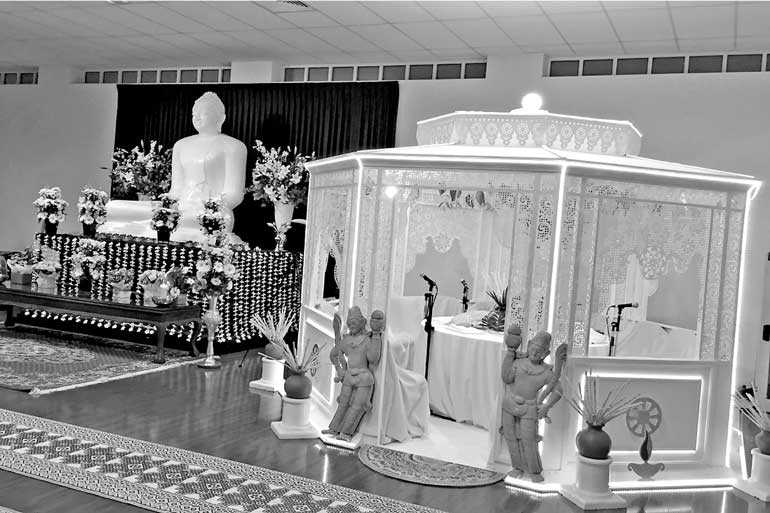Friday Apr 26, 2024
Friday Apr 26, 2024
Saturday, 13 October 2018 00:10 - - {{hitsCtrl.values.hits}}

‘Pirith mandapaya’ by the side of the Buddha statue in the preaching hall
Sri Lankan German Tech lads in Sydney won much praise about the ‘piirth mandapaya’ done by them for the all-night pirith ceremony held last week at Lankaramaya temple in Sydney.
The ‘mandapaya’ was meticulously planned and executed identical to what we have been used to seeing in Sri Lanka. The traditional ‘sandakada pahana’ – the moonstone, and the ‘mura gal’ – the guard-stones on either side of the entrance, were notable features.
The chief prelate of Lankaramaya, Ven. Meegahakumbure Dhammagaveshi Nayake Thera, paying tribute to the team, mentioned how within a matter a few days they did an excellent job. “They came after work and spent several hours every night to have the ‘mandapaya’ ready well in advance of the due date and time,” he said.
It was a rare sight to see 15 monks walking in, with drums beating and occupying the seats in the ‘mandapaya’. They turned up from temples in Adelaide, Brisbane, Melbourne and New Zealand.
 In addition to erecting the ‘mandapaya’, on the day after the ‘pirith’ ceremony the old boys of the Ceylon-German Technical Training Institute in Moratuwa arranged to give ‘dana’ to the monks who chanted ‘pirith’ and lunch to the hundreds of lay devotees present.
In addition to erecting the ‘mandapaya’, on the day after the ‘pirith’ ceremony the old boys of the Ceylon-German Technical Training Institute in Moratuwa arranged to give ‘dana’ to the monks who chanted ‘pirith’ and lunch to the hundreds of lay devotees present.
They went one step further and as a gesture showing their concern of the environment, in place of the plastic plates used to serve the food, they provided normal plates we use at home. Away from where the food was served, a team of 10 stayed behind a long table to clean, wash and wipe the used plates. A highly efficient operation it was.
The ‘pirith’ ceremony was arranged to mark the opening of a new building at the temple premises for the benefit of meditators who may like to spend a few days meditating under the guidance of the monks. Separate dormitories have been built for males and females with attached toilets. A well-equipped kitchen has also been provided. An interesting feature was the blessings offered by an Aboriginal Elder who spoke of “our land” being given for a worthy cause. After singing two songs in his indigenous language he played the didjeridu, the musical instrument that they all play. It is a simple wooden tube blown with the lips like a trumpet, which, it has been explained, gains its sonic flexibility from controllable resonances of the player’s vocal tract.
The all-night pirith ceremony was preceded by four days of continuous chanting in the evenings by the resident monks who followed the order of the ‘suttas’ as laid down in the ‘pirith poth vahanse’, the chronicle with all the ‘suttas’. These were repeated at one stretch during the all-night chanting.
